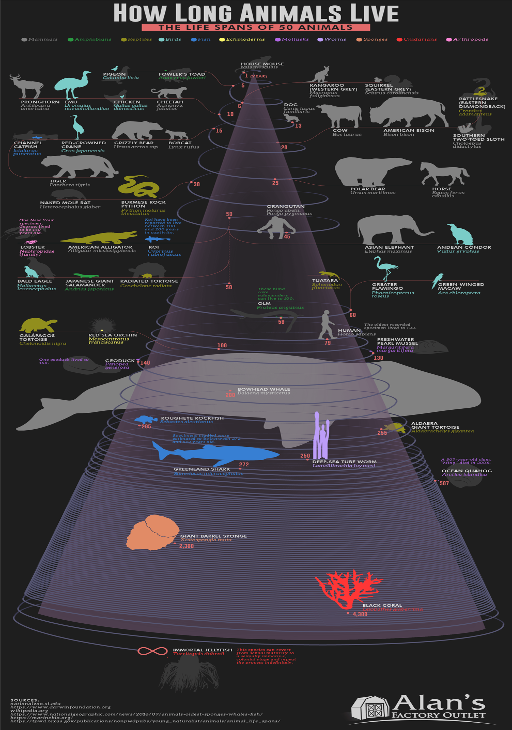By Vidya Rajan, Columnist, The Times
 This week, a Penn’s oak tree fell over in my neighborhood. It was on the grounds of the London Grove Meetinghouse, and we were all familiar with this venerable tree. It’s falling was a sad passing. Word spread on the grapevine, and we all went to pay our respects. A Penn’s oak is an oak which was presumed to have been alive when William Penn landed in Penn’s Sylvania in 1682, of wooded land gifted to him by England’s Charles II the previous year to pay off debts owed to his father. This tree would have been at least 341 years old. This is a venerable age for any living being. Few animals live as long. Jonathan, a Seychelles Aldabra tortoise who lives on the island of St. Helena, turned 190 in 2022. Recently, a newspaper article extolled a lungfish called Methuselah who arrived in the United States to take up residence at the Steinhart Aquarium in San Francisco in 1938[1]. There it has remained, outliving the 230 other fish that make that steamship journey from Australia 85 years ago. It may already have been 10-20 years old when it came over. Its longevity has been extraordinary among fish, but not among lungfish, who routinely live to be centenarians. A big question of course arises: How is longevity determined among the enormous diversity of living beings on the planet? A second question is, in the absence of birth records, how can we estimate longevity?
This week, a Penn’s oak tree fell over in my neighborhood. It was on the grounds of the London Grove Meetinghouse, and we were all familiar with this venerable tree. It’s falling was a sad passing. Word spread on the grapevine, and we all went to pay our respects. A Penn’s oak is an oak which was presumed to have been alive when William Penn landed in Penn’s Sylvania in 1682, of wooded land gifted to him by England’s Charles II the previous year to pay off debts owed to his father. This tree would have been at least 341 years old. This is a venerable age for any living being. Few animals live as long. Jonathan, a Seychelles Aldabra tortoise who lives on the island of St. Helena, turned 190 in 2022. Recently, a newspaper article extolled a lungfish called Methuselah who arrived in the United States to take up residence at the Steinhart Aquarium in San Francisco in 1938[1]. There it has remained, outliving the 230 other fish that make that steamship journey from Australia 85 years ago. It may already have been 10-20 years old when it came over. Its longevity has been extraordinary among fish, but not among lungfish, who routinely live to be centenarians. A big question of course arises: How is longevity determined among the enormous diversity of living beings on the planet? A second question is, in the absence of birth records, how can we estimate longevity?
For trees like the London Grove Penn’s oak, dendrology provides the answer. Dendrology is the science of counting tree rings, is a familiar theme in temperate regions which sees a growth season followed by a dormant season each year. The rings can be counted from the outside-in to establish a date of birth. In museums, massive cross-sections of long-lived trees such as redwoods. The sequoia tree slice in the photo is in the British Natural History Museum, and was felled in the 1890s.
But dendrology is not effective in the tropics where trees grow year-round. Those who has ever worked with ebony or mahogany are aware of the lack of distinct rings due to the lack of distinct seasons. Of course, a dry season may be distinguished from a wet season in some regions, but in rainforests, which have abundant humidity year-round[2], trees grow at a steady pace and the wood is of even grain. But dendrology is not unique to trees. Where annual growth spurts exists, annular rings exist. Fish otoliths – stones found in the ear – are made of layers of calcium carbonate laid down year upon year. After a fish dies, its otoliths can be extracted, sliced open, and the rings counted like those of a tree. Methuselah is still alive, so this is not possible, but a lungfish named Grandad, which died at the Shedd Museum in Chicago in 2022, was dated to 109 years old. Growth layers are also found in mussels. An ocean quahog clam called Ming (because it was born in 1499 when the Ming dynasty ruled China) was established as being 507 years old by counting the rings in the hinge of its valves. Unfortunately, the clam had been collected in 2006 and frozen, killing it, before its age was established[3].
Where simple layering is not possible, scientists turn to other tools, like genetics. Chromosomes are the famed “double helixes” of DNA which are replicated at each cell division. Because of the nature of replication the ends of the chromosomes, called telomeres, grow shorter at each division. Telomeres have repeated sequences, but also serve as buffers against the damage of vital genes which are located more internally in the chromosome. Since telomeres shorten in each replication, an older cell will have shorter chromosomes than a younger cell. This remains one of the key reasons why people cannot clone themselves. By the time someone grows egotistical enough to want a “Mini-Me”, their chromosomes have already undergone many tens of divisions, with shorter telomers leaving a shorter chromosome and consequently less longevity. A child made from such a cell will have a lower life expectancy. This was demonstrated by Ian Wilmut (who died recently) when he cloned the sheep Dolly, from her mother’s mammary gland cell.[4] Dolly lived to only 6 years old, about half the life expectancy of a sheep. By the age of four, she had developed arthritis. It is inferred that, as chromosomes shorten from the end inwards, vital genes incur damage. Around the same time, in Edinburgh’s MRC Unit, Adrian Bird was reporting the discovery of the methylation of DNA, particularly on stretches called CpG islands – stretches of DNA with the bases cytosine (C) and guanine (G). Methylation is a mechanism for shutting off gene expression, and he and others discovered that methylation was a process which increased as aging progressed. By measuring the percentage of methylated DNA to acetylated DNA, the proportion of genes turned off to those turned on were estimated. Today, this is called epigenetics – changes in gene expression that are not related to the actually sequences of the genes but to their regulation by secondary modifications[5]. Caloric restrictions and rapamycin treatments have been shown to affect aging through modifications of methylation.
Back to aging. Animals have widely different life expectancies as shown in this beautiful graph from “Alan’s factory outlet” (https://www.visualcapitalist.com/ranked-the-life-expectancy-of-humans-and-49-other-animals/) If you have time, go on and read through the site – Alan obviously has a great sense of humor. But regarding the Greenland shark, this timeline shows that they live to 250 years, and they may live well over 500+ years[6]. This is another reason, should you need one, for not eating sharks, especially Greenland sharks, which may be on the menu[7]. It is also right to desist buying marine sponges, which were living beings with centuries below their belt when they were harvested for the tourism trade.
In social honeybees and wasps, aging is linked to function. Young workers are typically hive-bound. They clean the hive, feed the larvae, store nectar, and ventilate the hive. Older workers graduate to functions such as guarding and foraging. The queen is exempt from these age-related roles. From the time she mates to the time she dies or is superseded she is an egg-layer. When her egg-laying falters or she starts laying unfertilized eggs (drone-layer), she is killed and another queen is raised by the hive. When seasons intervene, life expectancy changes. A typical worker lives 6 weeks in the spring and summer. In the winter, her life-expectancy soars to 6 months. Rather than raise brood or forage, the winter workers maintain cluster temperature. If the queen survives the winter, she begins laying fertilized eggs which will hatch into workers to sustain the hive to the spring. New queens may be raised and swarms – the reproductive products of a hive will form – and spread the successful genes for lifespan. Division of labor in honeybees has been linked to epigenetics, specifically the methylation of a handful of highly pleiotropic genes, which influence diverse, unrelated outcomes. The development of widely divergent phenotypes such as honeybee workers and queen, called polyphenism, is one such consequence. Another is the life expectancy: workers live about 6 weeks, but the queen can live up to 5 years. These effects appear to be a consequence of epigenetics, in which methyl groups are added to modify gene expression patterns[8].
Back to trees. The oldest living beings on the planet are thought to be bristlecone pines, native to California. And among these, the oldest is thought to be 4,900 years old[9]. This tree would have been born (3,000 BCE) when Stonehenge and the Giza pyramids were being beginning to be built, 500 years old when the epic Gilgamesh was written; 1,000 years old when the four Vedas of Hinduism were written down; 1,500 years old when the Buddha preached, 2,800 years-old when Jesus was born; and about 3,700 years old when Mohammed originated Islam. Today, almost 5,000 years into its life, we are at a point when religions, cultures, and beliefs are at loggerheads, each trying to overcome the other as the truth. The truth is that all are right, and yet all are wrong. Life endures. Whatever works, works because it helps endure.
Endurance. That is the truth.
[1]. Gammon, K. (2023, September 24). Methuselah arrived in the US in 1938. She’s now the oldest fish in captivity. The Guardian. https://www.theguardian.com/us-news/2023/sep/24/lungfish-australia-methuselah-san-francisco
[2]. Tree Rings and Climate | UCAR Center for Science Education. (n.d.). Scied.ucar.edu. https://scied.ucar.edu/learning-zone/how-climate-works/tree-rings-and-climate
3. Ming (clam). (2023, August 30). Wikipedia. https://en.wikipedia.org/wiki/Ming_(clam
- 4. Wikipedia Contributors. (2019, March 10). Dolly (sheep). Wikipedia; Wikimedia Foundation. https://en.wikipedia.org/wiki/Dolly_(sheep)
- Unnikrishnan, A., Freeman, W. M., Jackson, J., Wren, J. D., Porter, H., & Richardson, A. (2019). The role of DNA methylation in epigenetics of aging. Pharmacology & Therapeutics, 195, 172–185.
https://doi.org/10.1016/j.pharmthera.2018.11.001
- How long do Greenland sharks live? (n.d.). Oceanservice.noaa.gov. https://oceanservice.noaa.gov/facts/greenland-shark.html
- Wikipedia Contributors. (2023, August 17). Hákarl. Wikipedia; Wikimedia Foundation. https://en.wikipedia.org/wiki/H%C3%A1ka
- 8. Lattorff, H. Michael G., and Robin FA Moritz. “Genetic underpinnings of division of labor in the honeybee (Apis mellifera).” Trends in Genetics 29, no. 11 (2013): 641-648.
- 9. RMTRR OLDLIST. (n.d.). Www.rmtrr.org. http://www.rmtrr.org/oldlist.htm

Figure 1: A 1300-year old sequoia displayed in the British Museum of Natural History in London. Left – before cleaning, and right – after cleaning and varnishing. From https://www.nhm.ac.uk/discover/giant-sequoia-slice.html. Reproduced under Fair Use copyright law.

Figure: Lifespans of various animals. From https://www.visualcapitalist.com/ranked-the-life-expectancy-of-humans-and-49-other-animals/. Reproduced under Fair Use copyright law.






